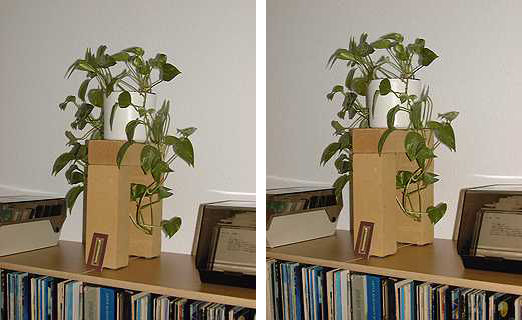
< 3D World
> Intro
• Overview
> Create
> Bryce
— 3D World: Anaglyphs, Overview —
What are Anaglyphs anyway?
Anaglyphs consist of two separate pictures, one for each the left and the right eye. Both pictures overlap and appear somewhat unfocused. The pictures are colour coded so that each eye may get the picture dedicated to it. To make sure each eye sees its picture, a filter between the picture and the eye is needed.
The filter consists of a pair of goggles with a red glass for the left eye and a blue, green, or preferably a green-blue i.e. cyan glass for the right one.
These «glasses» or «goggles» are usually of cheap quality (cardboard and coloured transparencies) and they are included in magazines sometimes. Sources of supply can be found when googling for "anaglyph".
Persons with impaired colour view, cannot perceive the 3D effect of anaglyphes.
As cheap as the needed glasses are, so «cheap» anaglyphs can be created — from snaphots out of the CCD- or CMOS-camera or from renderings of a raytracing program.
Raw Pictures
Two pictures must be acquired: one for the left and one for the right eye.
CCD/CMOS Camera
Make a snapshot from an object or a countryside, then move a few inches
sideways and make another snapshot. I have a habit of moving always to the
right, so I know that the first picture is for the left eye and the second
one for the right.
Raytracer
When having a scene that could be used for an anaglyph, move the camera
a bit to the left, render and save the picture as scene_left. Move the camera
to the right, render again and save the picture as scene_right.
How much the camera should be moved has to be determined by trial and error for each scene. Since the camera is moved to the left and to the right from the reference scene, that picture can be put as «half-right» next to the left picture. Test-anaglyphs with half and full distance can be made and compared against each other. You will get experienced soon how much is needed. For a typical Bryce landscape, I move between ±1.00 and ±5.00 units. The nearer the foreground, the smaller the distance to move the camera.
Distance between left and right picture
Ideally, the distance is the inter-eye distance, about 3 inches. The anaglyph
then appears natural. A giant may have its eyes 3 feet apart and such appears
the landscape as seen by a giant: miniaturized — with a pronounced 3D effect,
though. Similar, but the other way around, if a distance smaller than the inter-eye
distance is applied: the world as seen by a guinea pig.
Example
It is a bit more difficult to create an anaglyph from CCD-camera pictures then from
a raytracing program, because you cannot move the camera easily parallel. Just turn
the camera on a tripod will not work, of course. The example therefore takes a
photograph from a plant in a room, that had been taken with the camera holding in
the hands.
The almost identical pictures from which we will now create an anaglyph.
© 2004 - 2018 by Horo Wernli.

